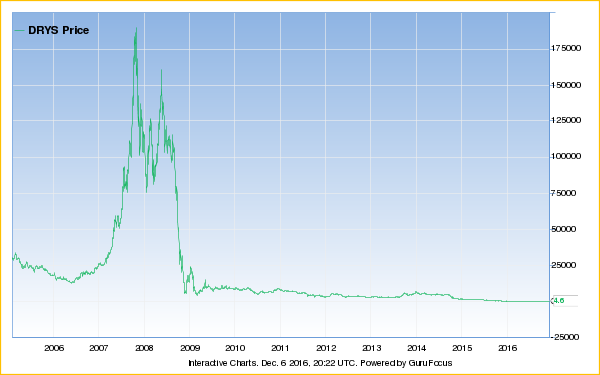Is There Value in the Shipping Sector?
- By Rupert Hargreaves
On valuation alone, the global shipping sector is probably the most attractive industry on the entire market. The dry bulk, tanker and box shipping industries are full of companies trading at a double-digit discount to net asset values.
For example, shares in companies such as Teekay LNG Partners (TGP), Frontline Ltd. (FRO), Euronav NV (EURN), Seaspan (SSW), Teekay Offshore (TOO), Costamare (CMRE), Navigator Holdings (NVGS), Diana Shipping (DSX), Safe Bulkers (SB), DryShips (DRYS), Scorpio Bulkers (SALT) and TOP Ships (TOPS) all trade at an average price-book (P/B) of less than 0.5. Such a discount implies an upside of 100% if confidence returns to the sector and the shares are bid up to asset value.
Warning! GuruFocus has detected 5 Warning Signs with DRYS. Click here to check it out.
The intrinsic value of DRYS
However, all of these companies have two significant issues overhanging their prospects.
Firstly, debt is proving to be a stranglehold for almost every company in the shipping sector. Secondly, a lack of the ability to set prices or lack of pricing power is only exacerbating the debt issue.
Structural issues
Shipping companies are price takers. They have to accept the prevailing rate for their services, which is influenced by supply and demand. Excess supply that has come to the market since the financial crisis coupled with stagnant demand has put downward pressure on shipping rates, but the average journey cost for these carriers has not seen the same deflation. With market forces working against shipping groups, Drewry, a consultancy, reckons the industry could lose as much as $10 billion this year on revenues of $170 billion. Even the world's largest shipping lines are struggling to break even. Of the 12 biggest shipping companies that have published results for the past quarter, 11 have announced massive losses. The collapse of Hanjin Shipping brought home the extent of the storm in shipping. It is estimated Hanjin was bleeding $100 per container moved this year.
The one industry that has done well
The one industry that has profited over the past 24 months is the oil tanker industry. As oil prices have plunged, traders have rented tankers to store oil offshore in an attempt to profit from price movements. However, it looks as if profitability in this industry is now set to come to an end. Rising demand for very large crude carriers has led to a spike in new orders for the vessels. Owners have taken delivery of 54 this year, with another 44 due in 2017. These are the biggest fleet additions since 2012. Yes, spot rates have doubled since August, yet the cost of renting one of these vessels is still less than at the same point in either of the last two years.
Not a play on the Baltic Dry
Some investors may think shipping companies, mainly dry bulk carriers, are an excellent way to play a recovery in global trade and a rebound in the value of the Baltic Dry Index. Indeed, year-to-date, the value of the Baltic Dry Index has rallied from just under 300 to 1,196 at the time of writing, a return of 150.2%. But as is the case with all indexes, this is just an indication of market sentiment and rates. Some companies will have vessels on contracts tied to the Baltic Dry Index although, after the slump in the value of the index earlier in the year, the recent rally will do little to make up for January's pain. Also, the most prudent companies will have fixed rates for the duration of charters to improve revenue and income visibility.
The bottom line
Overall, the shipping sector might look attractive to value investors at current levels but shipping stocks are cheap for a reason. Many are overloaded with debt and all lack the ability to set prices, which is a fundamental requirement of any attractive long-term value investment. It is probably wise to stay away from the sector.
Disclosure: Rupert does not own any stocks mentioned in this article.
Start a free 7-day trial of Premium Membership to GuruFocus.
This article first appeared on GuruFocus.
Warning! GuruFocus has detected 5 Warning Signs with DRYS. Click here to check it out.
The intrinsic value of DRYS

